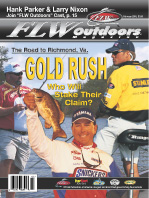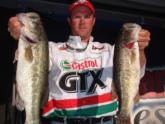The road to Richmond, Virginia

During the gold rush of the 1840s, Horace Greeley said, “Go west, young man.” But in the bass rush of the early 2000s, fishing hopefuls had better go east because the road to Richmond, Va., is paved with gold.
More specifically, the 2003 Wal-Mart FLW Tour is paying out $5.76 million en route to the season-ending Jacobs Cup on the James River.
Along the way, bass prospectors will probe lakes for top prizes of $100,000 in four qualifying events, top awards of $200,000 in the Wal-Mart Open and Forrest Wood Open, and the history-making $500,000 top prize in the Jacobs Cup.
Pros who do not tap into the mother lode can still uncover deep caches. The Wal-Mart Open on Beaver Lake features a significant payout boost that offers $10,000 to the 50th-place angler, and the top 48 pros competing for the Jacobs Cup will be guaranteed at least $12,200 even if they do not get a bite.
 When the Wal-Mart FLW Tour arrived on the tournament scene in 1996, it promised to bring new faces to professional bass fishing through increased payouts and exposure. Eight years later, the Wal-Mart FLW Tour is in a position to showcase a new breed of fishing talent.
When the Wal-Mart FLW Tour arrived on the tournament scene in 1996, it promised to bring new faces to professional bass fishing through increased payouts and exposure. Eight years later, the Wal-Mart FLW Tour is in a position to showcase a new breed of fishing talent.
Here is a preview of the 2003 Wal-Mart FLW Tour’s Road to Richmond, Va., from a few anglers who are looking to sack up a lot of gold along the way.
Lake Okeechobee
Clewiston, Fla., Jan. 22-25
Except for a brief detour to Lake Toho in 1998, the Wal-Mart FLW Tour has always kicked off on Florida’s Lake Okeechobee.
Although the FLW Tour always starts at the same place at roughly the same time, Okeechobee is hardly ever the same fishery two years in a row.
Fuji pro Joel Richardson of Kernersville, N.C., won the 1999 Okeechobee event. Under normal water conditions and warm weather, Richardson flipped big worms in eelgrass to win.
In 2000, Kellogg’s pro Steve Daniel of Clewiston, Fla., used his local knowledge of Okeechobee to fend off a brutal south Florida cold front, and he won the event on a suspending jerkbait.
In 2001, ultralow water conditions allowed cranking ace David Fritts of Lexington, N.C., to steal the show on a crankbait.
Last year, Okeechobee returned to a state of normalcy, and FLW Tour rookie J.T. Kenney of Frostburg, Md., won by flipping vegetation.
Stanley pro Scott Martin of Clewiston is looking forward to the Okeechobee opener on his home lake. “The hard, sandy bottoms are back, the vegetation is back, the water is up 2 feet higher than last year, and most importantly, there is clear water all over the lake,” Martin said.
Martin said that two years of low water allowed all of Okeechobee’s bays and flats to be exposed to air and sunlight. The mucky layer of decaying plant matter oxidized, and the result is clean sand, renewed vegetation and improved water quality.
 “All of the lake’s legendary areas have come back – the Monkey Box, Tin House Cove, King’s Bar, Bay Bottom, Ritta and Kreamer Island – they are all producing good catches,” Martin said. “Even places like Moonshine Bay are once again accessible.”
“All of the lake’s legendary areas have come back – the Monkey Box, Tin House Cove, King’s Bar, Bay Bottom, Ritta and Kreamer Island – they are all producing good catches,” Martin said. “Even places like Moonshine Bay are once again accessible.”
Okeechobee’s renewed vegetation includes eelgrass, hydrilla, peppergrass, hyacinths and reeds.
Martin said a flipping pattern will be in full force in January, and he predicted that pitching craws into matted hyacinths with 1-ounce weights will account for big catches.
With some decent weather, he said that the top-water lures will be strong, especially a Johnson Spoon reeled over top of the vegetation.
Traditionally, Okeechobee tournaments are won on the North Shore or in South Bay, but Martin believes the 2003 victor could come from anywhere on the lake, given its improved conditions.
Atchafalaya Basin
Morgan City, La., Feb. 12-15
The `X’ factor on the 2003 FLW Tour will be on the Atchafalaya Basin in Morgan City, La. Though the Atchafalaya Basin is a bass-tournament hot spot for local and regional tournaments, the basin has not hosted many national-level events. Therefore, the fishery does not have a lot of well-known tournament history like some of the tour’s other stops.
Greg Hackney of Oak Ridge, La., is a new name blitzing bass circuits across the nation. Last season Hackney finished 10th in the FLW Tour Angler-of-the-Year race, and he led the FLW Tour Championship for two days on Cross Lake before finishing 13th. Hackney expects another solid season on the FLW Tour in 2003, and the Atchafalaya Basin is one of the reasons why.
 “I have fished there before, and it is an awesome place both in terms of its beauty and its fishing,” Hackney said. “The last time I fished there was in February of 1999. I had an 18-pound stringer and finished 16th. It took 23 pounds to win.”
“I have fished there before, and it is an awesome place both in terms of its beauty and its fishing,” Hackney said. “The last time I fished there was in February of 1999. I had an 18-pound stringer and finished 16th. It took 23 pounds to win.”
Roughly, the Atchafalaya Basin is 18 miles wide and 150 miles long. Hackney describes the Basin as two different fisheries divided by Highway 90, which runs east and west. North of Highway 90, the basin is a complex maze of endless canals and creeks that connect dozens of shallow, cypress-strewn lakes. South of Highway 90 is tidal marsh that connects to the New Orleans Delta.
Fishing options at the Atchafalaya Basin are infinite. Essentially, anglers are limited only by fuel capacity. “We won’t have to worry about fishing in a crowd there,” Hackney said. “This place will eat up 175 boats in a second.”
Hackney favors the water north of Highway 90 and believes the tournament will be won there. “The extended drought has hurt some of the marsh fishing,” Hackney said. “The better-quality fish will be north of the bridge.”
Hackney predicts Atchafalaya bass will be spawning in February and flipping jigs and tubes will be the dominant fish-catching pattern.
Lake Murray
Columbia, S.C., March 12-15
Those familiar with the Wal-Mart FLW Tour will remember the last time the tour wet a line at Lake Murray in South Carolina in March of 2000. Sixteen-pound limits were par, and it took a 20-pound bag of bass to even draw a second glance from bystanders.
But Lake Murray might look different this March when the lake is expected to be 10 to 13 feet below normal.
According to the South Carolina Electric and Gas Web site, Lake Murray will be undergoing a prolonged drawdown starting in the fall of 2002. The lake will be lowered to 345 (normal elevation fluctuates between 350 and 358) for a period of two years to relieve water pressure on the dam so a reinforcement dam can be built.
No one can say exactly how low Lake Murray will be in March, but there is a good chance it will be much lower than any of the FLW Tour anglers have seen it before.
 “It will be like fishing a new lake,” said Lake Wylie, S.C., pro Todd Auten, who fishes Murray frequently. “I fished it this fall when it was about 7 or 8 feet low, but I have never seen it as low as it is supposed to be this spring.”
“It will be like fishing a new lake,” said Lake Wylie, S.C., pro Todd Auten, who fishes Murray frequently. “I fished it this fall when it was about 7 or 8 feet low, but I have never seen it as low as it is supposed to be this spring.”
Auten, who came off the waiting list late last season to claim fifth on New York’s Lake Champlain, is looking forward to fishing his first full season of FLW Tour events, specifically Lake Murray.
With an estimated 30 percent of the lake eliminated and most of the docks out of the water, Murray will have limited amounts of shallow-water cover. Speculation among pros is that Murray will fish extremely small.
Auten disagrees. “Murray usually fishes small in the spring because everybody is running the backs of pockets,” he said. “If the water is down 13 feet, there are not going to be any backs of pockets. As long as the water is clear, the fish will probably just spawn anywhere along barren stretches of bank. I really don’t know what to expect.”
Mid-March is when Lake Murray bass begin to fan out spawning beds. Low, clear water should improve anglers’ chances of spotting fish on beds. Lake Murray in 2003 could be a repeat of Murray in 2000.
Beaver Lake – Wal-Mart Open
Rogers, Ark., April 9-12
The 2003 Wal-Mart Open on Beaver Lake will be a historical week in professional bass fishing. The road to Richmond, Va., is paved with gold, and that gold gets thick as the road winds around Beaver Lake.
One of the highlights of the 2003 FLW Tour is the increased payback of $1.26 million at the Wal-Mart Open. The upper end of the payout will remain the same, but the lower-end payout has been boosted substantially: 61st-75th will get a returned entry fee, 51st-60th will get $5,000 and 41st-50th will receive $10,000.
 Many eyes will be on Kellogg’s pro Clark Wendlandt of Cedar Park, Texas, as he nears this halfway point in the season. Beaver Lake has been Wendlandt’s personal gold mine. Since 1999, he has earned more than $400,000 from Beaver Lake alone.
Many eyes will be on Kellogg’s pro Clark Wendlandt of Cedar Park, Texas, as he nears this halfway point in the season. Beaver Lake has been Wendlandt’s personal gold mine. Since 1999, he has earned more than $400,000 from Beaver Lake alone.
Wendlandt has announced his decision to fish the Wal-Mart FLW Tour exclusively in 2003. With all of his focus concentrated on just one tour, competitors should beware, particularly on Beaver Lake.
And what about the fishing on Beaver Lake? Last year Beaver was inundated with high, muddy water just before the Wal-Mart Open. But the tournament was in late April, and the water had a chance to warm up. By tournament time, Beaver Lake bass had moved into the flooded shoreline to make beds.
“The Wal-Mart Open is a little earlier than it has been the last couple of years, and that could hurt the way I like to fish there, especially if there is high water,” Wendlandt said. “From what I understand, the water never receded this year, so it might still be high in April.”
From experience on Beaver, Wendlandt has learned that when the water is both high and cold, the bedding bass are not responsive. “Even if there are a few on beds, they just swim away when you pitch a bait in there,” Wendlandt said. “When they will not address the bait, you might as well hang it up and find another way to fish.”
Kentucky Lake
Benton, Ky., May 14-17
The last time the FLW Tour visited Kentucky Lake was in May of 1998. Dan Morehead of Paducah, Ky., won that event. Morehead has also claimed three Wal-Mart Bass Fishing League titles and the 2002 EverStart Series Central Division tournament title on Kentucky Lake.
 In 2003, Morehead is looking to mine a little more gold out of his backyard. “The Kentucky Lake tournament will be right on the spawn-to-postspawn transition,” Morehead said. “I am hoping it will be more of a postspawn tournament and fish will be moving to the ledges.”
In 2003, Morehead is looking to mine a little more gold out of his backyard. “The Kentucky Lake tournament will be right on the spawn-to-postspawn transition,” Morehead said. “I am hoping it will be more of a postspawn tournament and fish will be moving to the ledges.”
Morehead said that the spawn on Kentucky Lake seems to be more influenced by water fluctuation than moon phase or temperatures.
“You can have the right moon and temperatures, but if the water level is not suitable, then they will hold off on spawning,” he said. “The opposite can happen as well. The temperatures may be a little cool, but if the water level gets right, they will head for the bank.”
When the water rises into the bushes on Kentucky Lake, it is a long-poler’s dream – flipping fanatics will have a field day.
Wheeler Lake – Forrest Wood Open
Florence, Ala., June 18-21
The FLW Tour has visited Wheeler Lake twice in previous years – 1998 and 2002. Both of those events were held in the late winter when snowsuits and toboggan caps were fashionable. The water temperature was in the 45- to 50-degree range, and fish were hibernating.
In 2003, the Forrest Wood Open plans to visit Wheeler Lake in late June, when fish will be well into a summer pattern. All three Wheeler Lake species – largemouth, smallmouth and spotted bass – should be very active.
 Greg Pugh from Cullman, Ala., is looking to collect some gold when the road to Richmond, Va., swings by his doorstep.
Greg Pugh from Cullman, Ala., is looking to collect some gold when the road to Richmond, Va., swings by his doorstep.
In the summer, Pugh divides Wheeler into three parts. He defines the river as the water from the Guntersville Dam to the 231 Bridge. Between the 231 Bridge and the Brown’s Ferry Nuclear Plant lies Wheeler Lake’s legendary Decatur Flats. Everything west of the nuclear plant is the lower end.
Pugh says the upper river, where the current is the strongest, is known for spotted-bass fishing, the Decatur Flats are known for producing quality largemouths, and the lower end is the best bet for big smallmouths.
Pugh predicts that most anglers will find their way to the Decatur Flats, where lush grass beds line the tops of ridges in 4 to 5 feet of water. In the Decatur Flats, anglers can catch largemouths on a variety of baits, including top-waters.
“Much of the lake’s overall productivity at that time will be determined by how much water is moving through the lake,” Pugh said. “If it is really hot, the power demand will be high, they will be pulling water to produce power, and the fishing will be great. If they are not pulling much water, weights will be down from what the lake is capable of producing.”
James River – Jacobs Cup
Richmond, Va., Sept. 10-13
When the road to Richmond, Va., finally ends at the James River for the Jacobs Cup, the Wal-Mart FLW Tour will again make history by paying $500,000 cash to the winner.
Such an enormous prize has particularly caught the attention of Castrol pro David Dudley of Manteo, N.C., who finds the combination of tidal fisheries and record tournament payouts particularly alluring.
In February of 2002, Dudley won the Ranger M1’s record payout of $700,000 on the Mobile Delta in Alabama.
 “I have not been on the James since I won an event there in 1995,” Dudley said. “But I’ll probably be on it a little more this upcoming year.”
“I have not been on the James since I won an event there in 1995,” Dudley said. “But I’ll probably be on it a little more this upcoming year.”
Curt Lytle’s jaw also dropped when he heard that the Jacobs Cup would be paying out $500,000 to the winner on the James River, which is near his hometown of Suffolk, Va.
“I am dying to make that championship,” said the FLW Tour pro. “What an opportunity that would be.”
Lytle said that the number of bass in the James River seems to have dwindled a bit in the past few years, but the overall quality of the bass is still good.
“A limit normally weighs 10 to 12 pounds, but catching a limit is the problem,” he said. “I think in September, 11 to 13 pounds a day will be huge, but a guy could survive eliminations with 6 to 8 pounds a day.”
The James River system, which includes the Chickahominy River, has about 60 to 70 miles of fishable water. The tide fluctuates about 2.5 feet. The dominant cover is laydowns, although some grass and lily pads grow in the Chickahominy.
Lytle points out that bass will be feeding heavily on baitfish that time of year and that patterning the shad will be important to cashing in on the James River.
Related links: